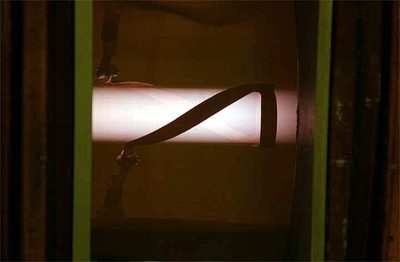It Could Propel Future Deep-Space Missions
 A team of engineers and scientists
led by NASA have begun investigating the physics and performance of
magnetic nozzles -- innovative devices that could support
development of plasma-based propulsion systems.
A team of engineers and scientists
led by NASA have begun investigating the physics and performance of
magnetic nozzles -- innovative devices that could support
development of plasma-based propulsion systems.
Such systems could dramatically reduce travel times to Earth's
neighboring planets and extend the capabilities of future space
exploration missions.
The project, initiated in April, is led by the University of
Texas at Austin and includes support by the Propulsion Research
Center, a key research organization at NASA's Marshall Space Flight
Center in Huntsville, Ala. The Propulsion Research Center leads
scientific study of advanced propulsion systems in NASA's
state-of-the-art Propulsion Research Laboratory at Marshall. The
Advanced Space Propulsion Laboratory at NASA's Johnson Space Center
in Houston and the University of Alabama in Huntsville also are
part of the research team.
The joint effort was selected from the competitive Broad Agency
Announcement No. 2203-3659, issued in July 2004 by the Exploration
Systems Mission Directorate at NASA Headquarters in Washington.
"The technology we're pursuing could play an important role in
NASA's exploration of the Moon, Mars and the rest of the Solar
System," said Dr. Greg Chavers, a plasma physicist at Marshall and
co-investigator for the new project. "Magnetic nozzles enable a new
type of plasma-based propulsion system that could significantly
reduce travel times to different planetary destinations, providing
a new means of exploring space."
Plasma is a highly conductive medium formed when a gas is heated
and ionized -- the process in which the gas's neutral atoms shed
electrons and acquire a positive charge. When properly channeled
through a magnetic nozzle, plasma can be accelerated to velocities
dramatically faster than those of conventional chemical propulsion
systems.
The new research project has two objectives: development of an
innovative magnetic nozzle design capable of directing the flow of
plasma, and determining how to efficiently eject the plasma from
the nozzle to produce the greatest propulsive thrust.
Magnetic nozzle development is critical, Chavers said.
Propellant in a plasma state can be accelerated with the use of
electromagnetic energy sources to increase the propulsion system's
specific impulse -- the equivalent of a car's gas mileage. Such a
nozzle, magnetically insulated against the superheated plasma flow,
would enable plasma acceleration at temperatures far beyond those
conventional materials can endure.
The second challenge is rooted in the physics of magnetized
plasma flow. A plasma propulsion system requires magnetic coils to
generate and channel the plasma. These coils produce closed
magnetic "field lines" -- circular loops of magnetic energy that
form around the power source, preventing the plasma from detaching
and leaving the spacecraft.

The research consortium seeks to test mechanisms that allow the
plasma stream -- already properly shaped by the magnetic nozzle --
to break away from the spacecraft, generating maximum thrust by
dispersing the plasma at exactly the right moment following
expulsion from the rear of the spacecraft.
Eventually, NASA hopes to adapt this research to develop a new
class of rockets incorporating magnetic nozzles and plasma
propulsion systems.
 ANN's Daily Aero-Term (05.17.24): Very High Frequency
ANN's Daily Aero-Term (05.17.24): Very High Frequency ANN's Daily Aero-Linx (05.17.24)
ANN's Daily Aero-Linx (05.17.24) ANN FAQ: Submit a News Story!
ANN FAQ: Submit a News Story! Classic Aero-TV: ANN Visits Wings Over The Rockies Exploration Of Flight
Classic Aero-TV: ANN Visits Wings Over The Rockies Exploration Of Flight Airborne Affordable Flyers 05.16.24: PRA Runway, Wag-Aero Sold, Young Eagles
Airborne Affordable Flyers 05.16.24: PRA Runway, Wag-Aero Sold, Young Eagles




